Rare is the project manager who has access to unlimited resources to execute a project. Even if resources are abundant during project planning, a nasty surprises may occur during execution. The critical resources which were supposed to be made available for your project, were not released from their current assignments. Their time for your project is scarce.. So you end up in managing constrained resources.
Resource optimization techniques, such as resource leveling and smoothing, help ensure that the team continues to meet scheduled milestones. The trick is to understand the difference between the two techniques—and when to apply them.
Resource Leveling
Resource levelingis a technique that aims to balance the demand for resources with the available supply, while possibly tweaking the project’s start and end dates.
Importance is given to resource availability. If a person is needed on multiple tasks that are scheduled concurrently, for instance, resolving that constraint might require scheduling the tasks sequentially. Similarly, if a critical machine is available on certain number of days or hours, the project schedule is adjusted to make maximum utilization of that machine during a time of its availability.
Resource Leveling may involve adjusting the project’s start and end dates to ensure that resources are utilized efficiently and effectively. The primary focus is on resource availability, and it tries to resolve conflicts where resources are needed for multiple tasks scheduled concurrently. Resource leveling can consume any available float (schedule flexibility) and may alter the project’s critical path.
Example – Resource Leveling
Let me explain Resource Leveling with the help of an example. Let us consider a small project having five activities—A, B, C, D, and E.
The figure below shows a network diagram for our example project. We can see that activity E is dependent on activities A, B, C, and D. Activity E can start only after all of its predecessors are finished.

Let us assume each activity can be done by a one person in an eight hour working day. The figure below shows the time-phased project schedule.

Resource 1 in this project is clearly over-allocated. In Microsoft Projects, you can see a Resource Graph to find out its over allocation.
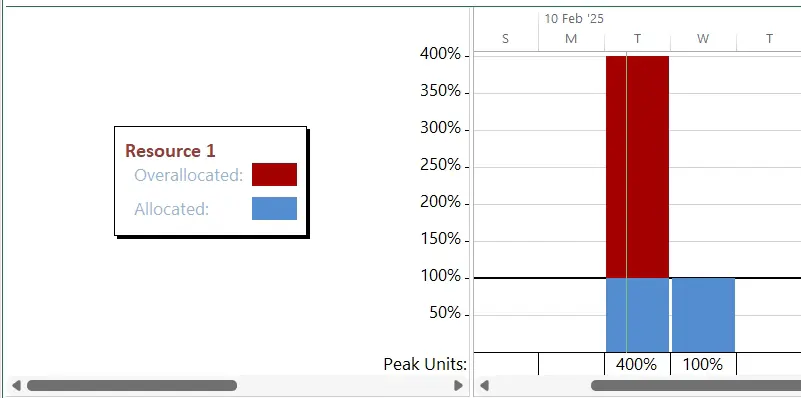
Looking at a resource graph, it is over-allocated by 400% (since it involves 32 hours of work). So, we would need 4 resources on Day 1 and one resource on Day 2. In this case, four resources would be too many. I’ll explain why.
Let us assume that only two resources (Resource 1 and Resource 2) are allocated to the project. Resource 1 and Resource 2 will work on Day 1 to finish activities A and B and C and D respectively. The figure below depicts the resource utilization levels of these two resources.
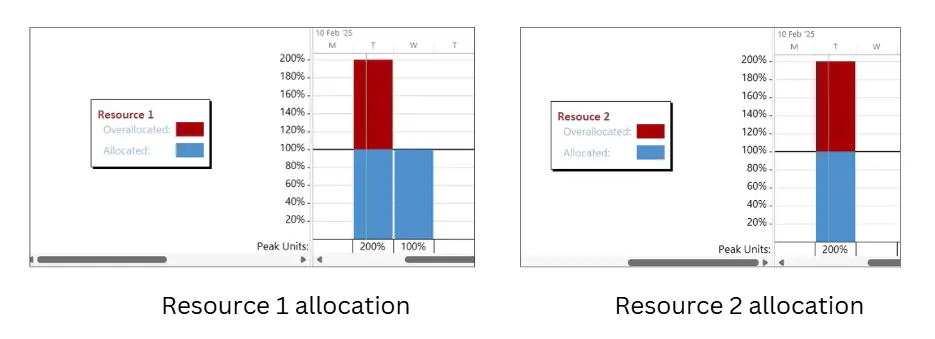
Notice that both Resource 1 and Resource 2 are working 16 hours on Day 1. This is far from an ideal scenario. A resource can work for a maximum of eight hours per day. Hence, the schedule needs to be adjusted.
The following figures depict the resource adjusted schedule with two resources.

You will notice that activities B and D have been delayed to Day 2 in order to remove the over-allocation. Now, we’ll look at a depiction of the resource utilization level in the adjusted schedule.
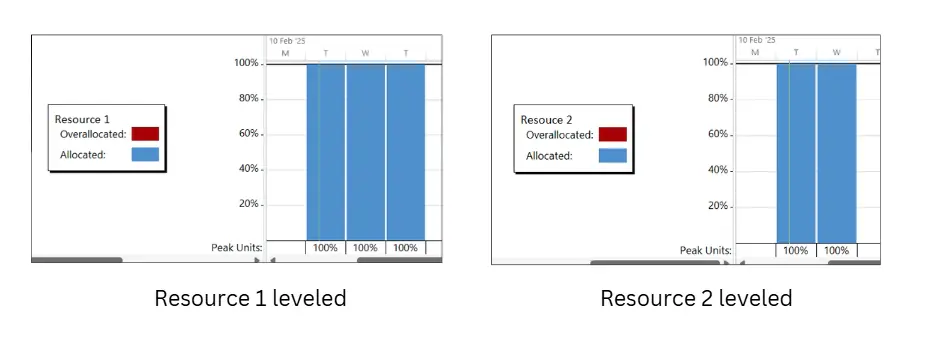
You will notice that, in the above figure, both the resources are leveled. Both resources will each work for eight hours per day.
In resource leveling, resource usage is maintained at a constant level, but the project schedule may be compromised. In this simple example, the project duration is increased by 1 day. MS Projects has a feature to automatically level the resources.
Interested in learning Microsoft Projects skills. Check out my 18 HOURS LIVE ONLINE training program on Microsoft projects for Absolute Beginners.
Resource Smoothing
Resource smoothing, is a technique that’s used when the project’s activities can be adjusted within their free and total float, but the project’s completion date cannot change.
Resource Smoothing removes as much of the resource conflicts as possible but may not remove all of them. Importance is given to the duration of the project, and it may require additional resources. The critical path remains untouched, and because of that not all resources are necessarily optimized.
Resource smoothing aims to even out the allocation of resources, so there are fewer peaks and troughs in how resources are used across the project schedule.
Example – Resource Smoothing
Let me explain Resource Leveling with the help of an example. Let us consider a small project having five activities—A, B, C, D, and E.
The figure below shows a network diagram for our example project. We can see than Activity B is dependent on A and activity E is dependent on activities A, B, C, and D. Activity B and E can start only after all of its predecessors are finished.

Resource 1 in this project is clearly over-allocated. It will work for 16 hours completing Task A and Task C on the first day of a project. In Microsoft Projects, you can see a Resource Graph to find out its over allocation.
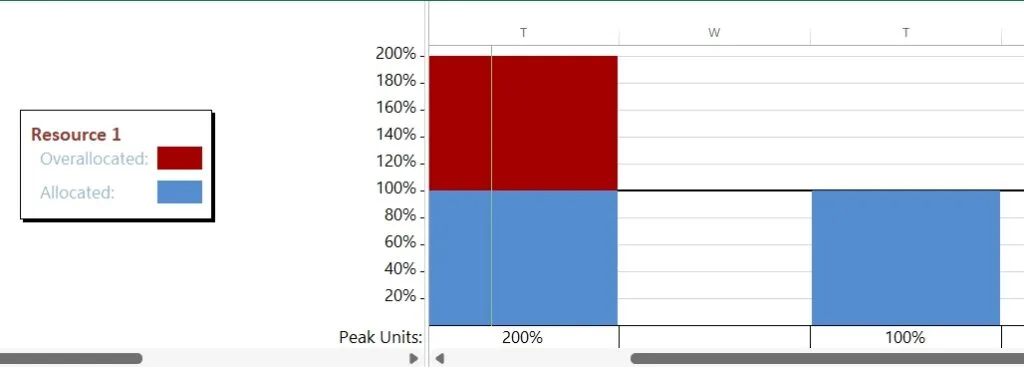
This over-allocation of Resource 1 can be resolved using Total Float available in activity C. Activity C is not on Critical Path (shown in orange color), hence Activity C can be shifted to Day 2 without affecting a Project Finish Date. This is illustrated in the figure below.

After we shift Activity C to Day 2, the schedule will look as below. The over-allocation of Resource 1 is also resolved. Please note, Project Duration is still 3 days, however a critical path is changed with Activity C gets added onto Critical Path.

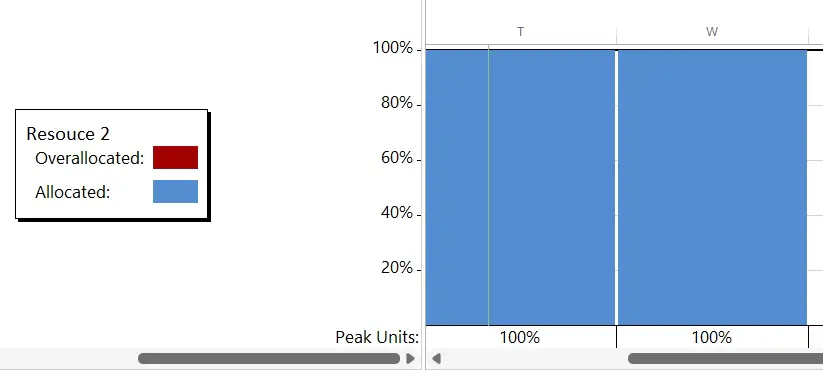
As demonstrated in this example, In resource smoothing, you have to make the use of available resources to finish the project within the given target finish date. You can use total and free float to adjust the activities’ start and finish dates.
When to use each Technique?
While both techniques can help bridge the gap between available resources and the ideal project schedule, they’re not interchangeable.
Resource smoothing is deployed when time is of the utmost importance and the project schedule cannot be extended.
Resource leveling comes into play when resource constraint, rather than time, is paramount. The project’s end date is adjustable, based on how the project manager is able to best allocate the available resources.
Summary
In summary, resource leveling is a crucial technique in project management that helps in managing resource constraints by adjusting project schedules. On the other hand, resource smoothing is a valuable technique for managing resource allocation efficiently within the existing project schedule constraints.
Further Resources
You can carry out resource leveling very effectively in Microsoft Projects. Interested in learning Microsoft Projects. Check out my 18 HOURS LIVE ONLINE course in Microsoft Projects for Absolute Beginners.
Here is nice article written by Microsoft on resource leveling in Microsoft Projects.




